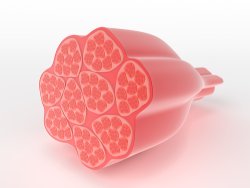Authors:
A number of scientists researches this mechanism of aging, among them are
History:
 Owing to investigations made by L. Hayflick and
Owing to investigations made by L. Hayflick and
Example:
 In adult skeletal muscle, where the resident dedicated stem cells («satellite cells») are capable of rapid and highly effective regeneration in response to injury, there is a loss of regenerative potential with age.
In adult skeletal muscle, where the resident dedicated stem cells («satellite cells») are capable of rapid and highly effective regeneration in response to injury, there is a loss of regenerative potential with age.
Description:
Tissues are maintained through a balance of cellular aging and regeneration.  Aging refers to the gradual loss of cellular function. And regeneration is the repair of damaged tissue that allows preserving tissue function in an organism. Tissue regeneration is generally mediated by
Aging refers to the gradual loss of cellular function. And regeneration is the repair of damaged tissue that allows preserving tissue function in an organism. Tissue regeneration is generally mediated by
 With age, there is a gradual decline in the regenerative properties of most tissues. This decline is linked to a decreased number of stem cells, their dysfunction in
With age, there is a gradual decline in the regenerative properties of most tissues. This decline is linked to a decreased number of stem cells, their dysfunction in
It should be noted that defective regulation of regenerative processes may account for the
Additions and Criticism:
Cell aging is a universal phenomenon. Scientists observed
Publications:
- Conboy, Irina M., and Thomas A. Rando. «Aging, stem cells and tissue regeneration: lessons from muscle." Cell cycle 4.3 (2005): 407–410.
- Pekovic, Vanja, and Christopher J. Hutchison. «Adult stem cell maintenance and tissue regeneration in the ageing context: the role for A‐type lamins as intrinsic modulators of ageing in adult stem cells and their niches." Journal of anatomy 213.1 (2008): 5–25.
- Smith, James Oliver, et al. «Skeletal tissue regeneration: current approaches, challenges, and novel reconstructive strategies for an aging population." Tissue Engineering Part B: Reviews 17.5 (2011): 307–320.
- Elmore, Lynne W., et al. «Upregulation of telomerase function during tissue regeneration." Experimental biology and medicine 233.8 (2008): 958–967.